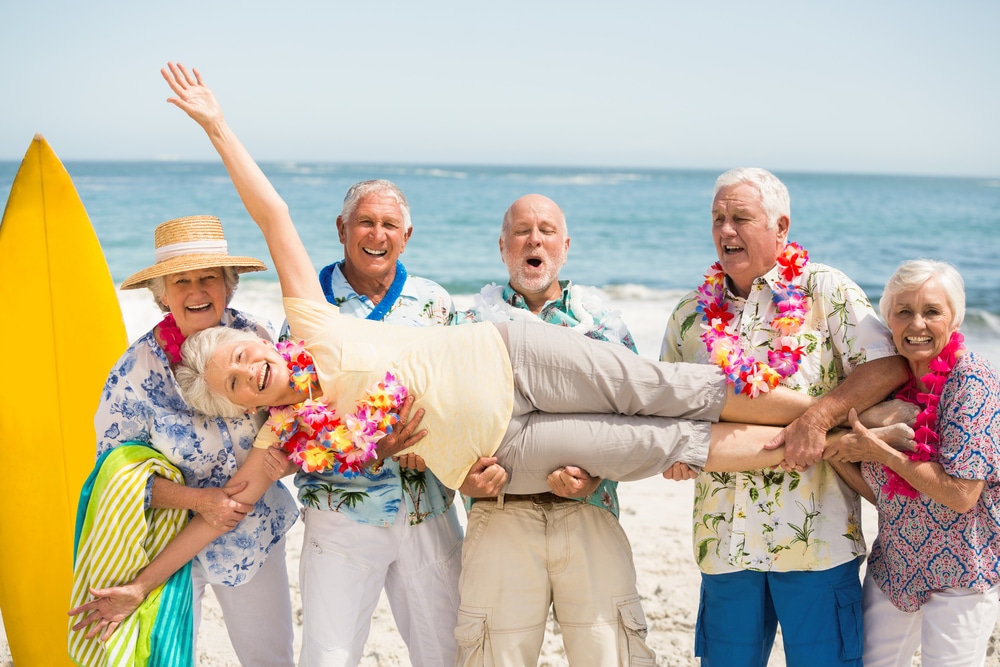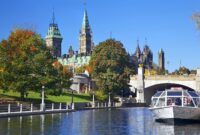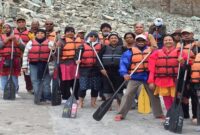Vacations for senior citizens offer a unique opportunity to explore new horizons, relax, and create lasting memories. This guide delves into the essential aspects of planning a fulfilling and safe getaway for older adults, considering factors such as budget, health, accessibility, and choosing the right destination. Whether you envision an adventurous expedition or a tranquil retreat, we provide the information and resources you need to plan a memorable trip.
From selecting the ideal type of vacation – be it adventure, relaxation, cultural immersion, or historical exploration – to budgeting effectively and ensuring safety, this comprehensive guide covers every stage of the planning process. We will also explore the importance of accessible travel options and age-appropriate activities to create a truly enjoyable and stress-free experience for senior travelers.
Health and Safety Considerations
Planning a vacation is exciting, but for senior citizens, ensuring a safe and healthy trip requires extra attention. Prioritizing health and safety measures can transform a potentially stressful experience into a relaxing and enjoyable adventure. This section outlines key considerations to help you travel with peace of mind.
Travel Insurance and Medical Assistance
Comprehensive travel insurance is paramount for senior travelers. It provides crucial financial protection against unexpected medical emergencies, trip cancellations, lost luggage, and other unforeseen circumstances. Policies often include medical evacuation coverage, which can be particularly vital in remote locations or countries with limited medical facilities. Consider policies that offer 24/7 access to medical assistance services, including help with finding doctors, arranging hospital stays, and facilitating communication with family back home. The cost of such insurance is a small price to pay for the considerable peace of mind it offers. For example, a policy covering medical evacuation could save tens of thousands of dollars in the event of a serious illness or injury abroad.
Potential Health Risks and Preventative Measures
Senior travelers face unique health risks, including heart problems, respiratory issues, falls, and heatstroke. Proactive steps can significantly mitigate these risks. Staying hydrated is crucial, especially in warm climates. Regular exercise before and during the trip can improve cardiovascular health and reduce the risk of falls. Choosing accommodations with accessible facilities can prevent strain and injuries. Packing appropriate clothing for varying weather conditions helps avoid overheating or hypothermia. Furthermore, consulting your physician before travel for a checkup and advice on necessary vaccinations or medications is highly recommended. For instance, if you have a history of heart problems, carrying your medication and having a plan for accessing medical care in case of an emergency is essential.
Packing Essential Medications and Medical Supplies
Careful preparation is key to managing health needs during your trip. It’s crucial to pack enough medication for the entire trip, plus a few extra days’ supply in case of delays. Carry a detailed list of your medications, including dosages and any potential interactions. Consider a doctor’s note or prescription to avoid issues with customs or airport security. Additionally, packing essential medical supplies such as bandages, antiseptic wipes, pain relievers, and any personal medical devices is highly advisable.
- Sufficient medication for the entire trip, plus extra days’ supply.
- A detailed list of medications, dosages, and potential interactions.
- Doctor’s note or prescription for medications.
- Bandages, antiseptic wipes, and pain relievers.
- Personal medical devices (e.g., inhaler, blood pressure monitor).
- Copies of medical records and insurance information.
Choosing the Right Destination
Selecting the perfect vacation destination for senior citizens requires careful consideration of several key factors. The ideal location should offer a balance of relaxation, cultural enrichment, and accessibility, ensuring a comfortable and enjoyable experience. This section will explore popular destinations, comparing and contrasting them based on climate, accessibility features, and cultural attractions. We will also discuss how to assess the safety and security of a potential travel location.
Popular Destinations for Senior Travelers
The choice of destination significantly impacts the overall vacation experience. Several factors contribute to the suitability of a location, including climate, accessibility of transportation and accommodations, and the availability of engaging cultural attractions. Destinations catering to senior travelers often prioritize comfort, convenience, and safety.
| Destination | Climate | Accessibility | Key Attractions |
|---|---|---|---|
| Charleston, South Carolina, USA | Subtropical; mild winters, hot humid summers. Generally pleasant spring and fall. | Relatively flat terrain, good public transportation in the historic district, many hotels offer accessible rooms. | Historic architecture, horse-drawn carriage rides, charming streets, plantation tours, culinary scene. |
| San Sebastian, Spain | Temperate; mild winters, warm summers. Pleasant throughout the year. | Generally walkable, good public transportation, many accessible accommodations. | Stunning beaches, rich history, delicious Basque cuisine, beautiful architecture, numerous churches and cathedrals. |
| Kyoto, Japan | Four distinct seasons; hot, humid summers; cool, crisp autumns; mild winters; pleasant springs. | Excellent public transportation (trains and buses), many accessible hotels and temples, generally well-maintained infrastructure. Note that some older temples may have limited accessibility. | Ancient temples and shrines, traditional gardens, geisha districts, serene atmosphere, cultural experiences like tea ceremonies. |
Assessing Destination Safety and Security
Prioritizing safety and security is paramount when planning a senior citizen’s vacation. Thorough research should be conducted to understand the crime rates, healthcare infrastructure, and emergency services available in the chosen destination. Consulting travel advisories issued by government agencies, reading online reviews, and seeking recommendations from other senior travelers can provide valuable insights into the safety and security aspects of a potential travel location. Consider factors such as the prevalence of petty theft, the availability of reliable medical facilities, and the ease of communication with emergency services. Choosing well-lit and populated areas, particularly during nighttime, is also advisable.
Transportation and Accessibility
Planning transportation is a crucial aspect of ensuring a smooth and enjoyable vacation for senior citizens. Careful consideration of accessibility needs and preferences will significantly impact the overall experience, allowing for comfortable and stress-free travel. This section will explore various transportation options and highlight the accessibility features available to cater to diverse needs.
Air Travel Accessibility
Air travel offers seniors the opportunity to reach destinations worldwide. Many airlines provide assistance for seniors with mobility challenges. This includes wheelchair assistance at airports and on board the aircraft, priority boarding, and assistance with baggage. Some airlines offer pre-boarding services to allow seniors extra time to settle in. Passengers should contact their airline in advance to request any necessary assistance and to confirm the availability of specific services. Consider booking aisle seats for easier access to the restroom and for more legroom.
Cruise Ship Accessibility
Cruises offer a convenient and accessible mode of transportation, often with amenities specifically designed for seniors. Many cruise lines offer accessible cabins with wider doorways, roll-in showers, and grab bars. Wheelchair access is typically available throughout the ship, including restaurants, theaters, and common areas. Shore excursions often offer options catering to varying mobility levels. However, it’s vital to check with the cruise line beforehand to confirm accessibility features and request any necessary assistance.
Escorted Tours and Accessibility
Escorted tours provide a convenient and structured travel experience. Many tour operators cater specifically to senior travelers, offering itineraries with a slower pace and fewer strenuous activities. These tours often include accessible transportation, such as motor coaches with wheelchair lifts and ramps. Accommodation is typically chosen with accessibility in mind. However, it’s crucial to communicate any specific accessibility requirements to the tour operator when booking to ensure a suitable experience. The operator can advise on the suitability of specific tours given an individual’s needs.
Tips for Comfortable Senior Travel
To minimize stress and maximize comfort during travel, several strategies can be implemented. Planning ahead and booking flights and accommodations in advance is essential, particularly for those requiring special assistance. Packing light and using lightweight luggage reduces the physical strain of carrying bags. Taking frequent breaks during travel, staying hydrated, and maintaining a comfortable pace are vital for well-being. Consider travel insurance that covers medical emergencies and trip interruptions. Furthermore, carrying a copy of any necessary medical information and contact details is recommended. Lastly, inform family or friends of travel plans and itinerary.
Activities and Entertainment
A well-rounded senior vacation should incorporate a balance of relaxation and engaging activities tailored to individual preferences and physical capabilities. The goal is to create a memorable experience that promotes well-being and fosters a sense of accomplishment, rather than feeling rushed or overwhelmed. Careful planning is key to ensuring a successful and enjoyable trip.
Choosing activities that are both stimulating and comfortable is paramount. Overly strenuous activities should be avoided, while sedentary activities should be balanced with opportunities for gentle movement and exploration. Consider the interests and physical limitations of each traveler when making selections.
Age-Appropriate Activities for Senior Travelers
A diverse range of activities can cater to the varied interests of senior travelers. Gentle hikes on well-maintained trails offer opportunities for light exercise and scenic views. These trails should be chosen carefully, prioritizing shorter distances and minimal elevation changes. For example, a leisurely stroll through a botanical garden offers a peaceful environment and opportunities for observation and learning. Alternatively, a guided cultural tour of historical sites or museums provides intellectual stimulation and a deeper understanding of local history and traditions. A visit to a local art gallery or a performance at a community theater offers alternative forms of cultural engagement. Finally, relaxing spa treatments, such as massages or aromatherapy sessions, promote physical and mental well-being.
Choosing Activities Based on Interests and Physical Abilities
Before finalizing the itinerary, it is crucial to assess the interests and physical capabilities of each traveler. Consider pre-existing health conditions, mobility limitations, and stamina levels. For example, individuals with limited mobility may benefit from wheelchair-accessible tours or activities that involve minimal walking. Those with heart conditions should avoid strenuous activities. A pre-trip consultation with a physician is recommended to discuss any potential health concerns and obtain guidance on appropriate activities. Creating a personalized itinerary that accommodates individual needs ensures a safe and enjoyable vacation for all participants.
Sample Senior Vacation Itinerary: A Blend of Relaxation and Activity
This sample itinerary focuses on a seven-day trip to a coastal region, balancing relaxation with gentle activity and cultural exploration.
| Day | Activity | Description |
|---|---|---|
| Day 1 | Arrival and Relaxation | Check into a comfortable hotel with accessible amenities. Enjoy a relaxing afternoon by the pool or on the beach. |
| Day 2 | Coastal Walk and Lunch | Enjoy a gentle walk along a scenic coastal path. Have lunch at a seaside restaurant. |
| Day 3 | Cultural Tour | Guided tour of a local historical site or museum. |
| Day 4 | Spa Day | Relaxing spa treatments, including massage and aromatherapy. |
| Day 5 | Boat Trip | Scenic boat trip with minimal motion, offering views of the coastline and wildlife. |
| Day 6 | Local Market Visit and Cooking Class | Visit a local market to experience local produce and culture. Participate in a gentle cooking class focusing on local cuisine. |
| Day 7 | Departure | Check out of hotel and depart for home. |
Closing Summary
Planning a vacation for senior citizens requires careful consideration of various factors, but the rewards are immeasurable. By prioritizing health, safety, and accessibility, while selecting destinations and activities that align with individual interests and abilities, you can create a truly unforgettable experience. Remember, the goal is to enjoy a well-deserved break filled with relaxation, discovery, and the creation of cherished memories. This guide provides the framework; your personal touch will make it unique and special.




